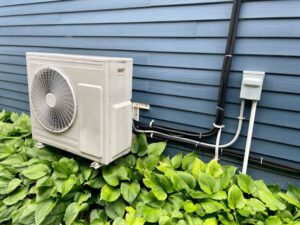Can a Ductless Mini Split Work in Cold Weather?

Although there are many ways to heat and cool your Houston, TX home, a ductless mini-split might be the most efficient. Ductless mini-split heat pumps provide year-round heating and cooling. Moreover, during the warmer months, some of these units boast efficiency levels as high as 300%. They don’t require HVAC ductwork, and they offer zoned air delivery for customized comfort. However, many people are hesitant to have them installed due to their reputation for low-performance in winter. Read on to find out why a ductless mini-split system can be just as reliable during the cold season as it is in summer.
How Ductless Mini-Split Heat Pumps Work
Like central air conditioners, ductless mini-split heat pumps have both indoor and outdoor components. Every ductless mini-split has an outdoor condensing unit that’s installed on a level, concrete or composite pad. This is attached to one or more indoor air handlers that distributes heated and cooled air in individual zones or rooms. During summer, ductless mini-split systems are functionally identical to air conditioners. These units harness warm air from the interior of buildings and pass it over their refrigerant-filled evaporator coils. Once chilled and filtered, this air is routed back inside to lower indoor temperatures.
In winter, you can reverse the operations of a mini-split system so that warm air is harnessed from outside of the building and deposited indoors. Also known as ductless air-source heat pumps, these units can source enough warm outdoor air to heat homes even when temperatures are as low as 30 degrees Fahrenheit.
Why Cold Winter Weather Is Sometimes an Issue
In extremely cold environments, ductless mini-split systems have a progressively harder time sourcing outdoor warmth the more that outside temperatures fall. Although some mini-split systems serve as reliable heat sources when outside temperatures are well below freezing, their efficiency levels decline. For instance, the same mini-split that operated at 300% efficiency during summer might have an efficiency level of just 60% whenever outside temperatures dip well below zero degrees Fahrenheit. The concerns about having an under-performing ductless mini-split in winter go beyond having a larger carbon footprint and higher energy bills. There may be times when an under-performing mini-split leaves building residents struggling to get warm. When air-source heat pumps cannot source enough outside heat, these units often run non-stop without ever achieving residents’ preferred temperatures.
Why Ductless Mini-Split Systems Are Increasingly Popular in Houston
The good news is that Houston winters are rarely cold enough to exceed the operating thresholds of ductless mini-splits. During the winter months, the average low for daytime temperatures is 60 degrees Fahrenheit, and nighttime temperatures in the region rarely dip below the mid-40s. Even basic, low-cost mini-splits will provide consistent performance in this climate. Houston is also home to a number of old, historic properties. Much of this existing construction was built without the ductwork for supporting modern, central HVAC systems. In these homes, installing ductless mini-split heat pumps for year-round heating and cooling eliminates the need to pay for costly ductwork retrofitting projects that might reduce usable indoor space and diminish indoor aesthetics.
The Type of Mini-Split You Own Matters
If you want to use a ductless mini-split as your sole or primary source of heating, the type of mini-split that you install matters. All ductless mini-splits aren’t created equally. You can choose from options that can support as many as eight indoor air handlers. You can also find mini-split systems with air handlers that have slim, inconspicuous profiles and multiple remote functions. However, among the most important factors to consider, when shopping these products, is their temperature range. This factor is key for gauging cold-weather performance. For the lowest upfront cost, you can get a budget-friendly or economy mini-split that provides efficiency levels as high as 100% at temperatures as low as 30 degrees Fahrenheit.
If the outdoor temperature dips much lower than this, an economy-level mini-split will still heat your home, but your operating costs will rise. However, if the outdoor temperature ever falls below 20 degrees Fahrenheit, you’ll have to have an alternative or back-up heating solution. At this temperature, many economy-level mini-splits are in danger of freezing up. Mid-level mini-splits can maintain efficiency levels of 100% all the way down to 20 degrees Fahrenheit. They work well at lower temperatures too, but the cost of using them increases. Moreover, when installed in areas with winter temperatures that are consistently below freezing, mid-level mini-splits often require base pan heaters. These heaters are installed in their outdoor units to promote water drainage during defrosting cycles and to prevent their coils from freezing over.
In extremely cold winter climates, the best choice is a low ambient mini-split. Also known as a high-performance mini-split, a low ambient mini-split can maintain 100% efficiency at just zero degrees Fahrenheit. It will additionally serve as a reliable heat source when outdoor temperatures dive down into the negatives, albeit at reduced efficiency.
Using Ductless Mini-Split Systems for Supplementary Heating
When ductless mini-split heat pumps are used for supplementary heating, there’s usually far less concern about how well they’ll perform in extremely low temperatures. If you already have a central furnace or boiler installed, you can use your mini-split on moderately cold days and turn it off when the risk of icing is high. Some homeowners use mini-split heat pumps as primary heating sources for remote building areas that aren’t connected to their ducted HVAC systems. These include finished basements, attic bedrooms, and attached garages, among other spaces. In these instances, it may be possible to heat remote rooms, when temperature drops exceed a mini-split’s limitations, by letting warm air migrate from other areas of the building as the central heating system provides it.
However, if a low-performing heat pump ices over and stops working entirely, there’s always the potential for remote areas to become temporarily uninhabitable.
Consider the Ongoing Efficiency Losses of Ducted Heating Systems
In Houston and in other areas in which winter weather is moderate overall, a ductless mini-split’s wintertime losses in efficiency could be a point of concern. It’s important to note that ducted, central HVAC systems experience efficiency losses too. Although you might have a furnace with an annual fuel utilization efficiency (AFUE) rating of 98.5%, this doesn’t mean that your heating system is operating at 98.5% efficiency. According to the U.S. Environmental Protection Agency (EPA), throughout the year, most ducted HVAC systems lose between 25% and 40% of their heating and cooling output via HVAC air duct heat losses and heat gains.
Given that ductless mini-split systems release heated and cooled air right where it’s produced, none of the energy they consume is wasted during distribution. There’s also the fact that ductless mini-splits are zoned for efficiency. With a separate air handler and thermostat in every zone or room, everyone can customize the temperature in their immediate areas to their own liking. This also eliminates the need to heat spaces that no one is actively using.
Mini-Splits: A Viable Option for Specific Regions
We’re committed to helping residents of Houston, TX make informed decisions about their heating and cooling systems. We offer air conditioner, furnace, boiler, and heat pump installation, maintenance, and repairs. We also provide ductless mini-splits, central HVAC zoning, and cutting-edge indoor air quality solutions. Get in touch with The Lee Thompson Co. today to find out more or schedule an appointment!

